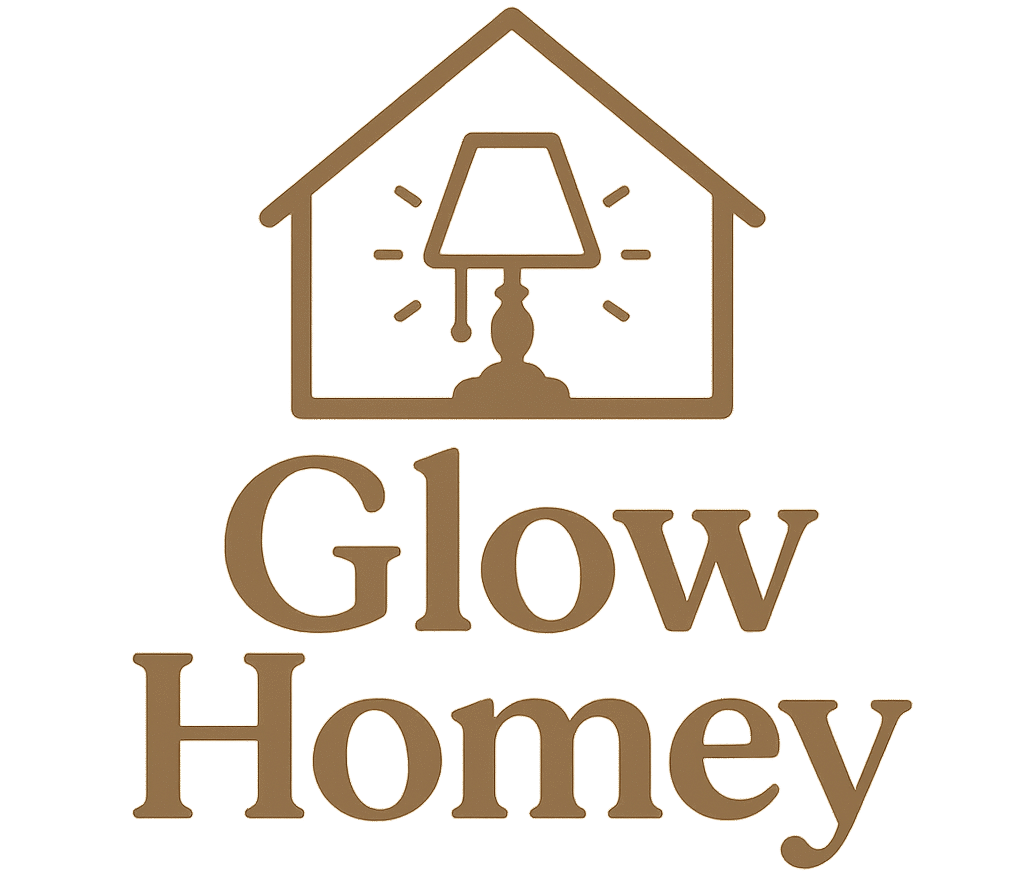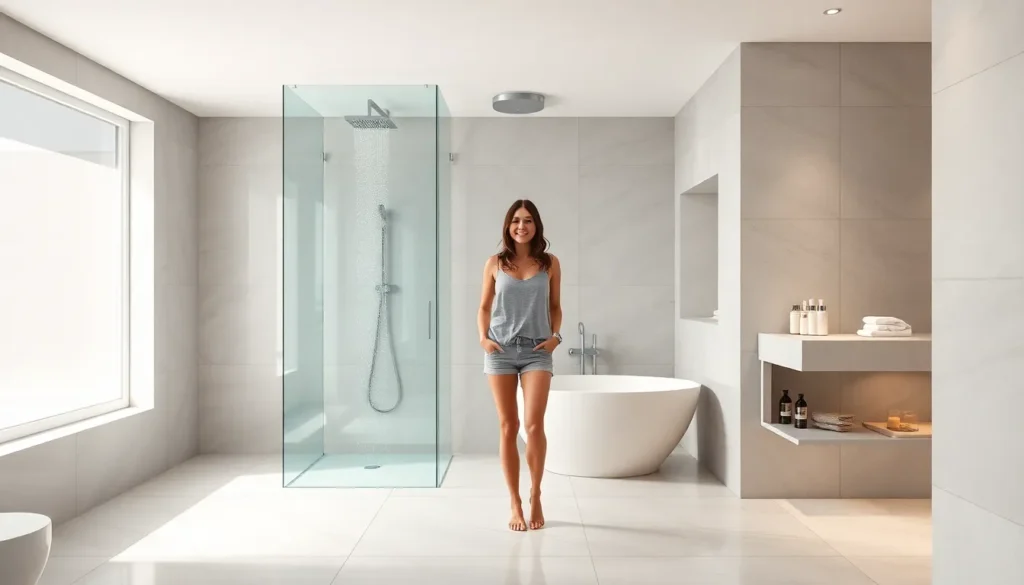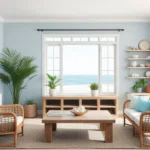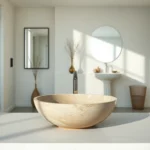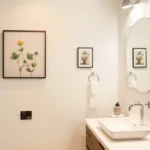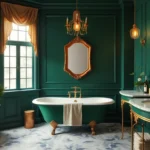We’ve all dreamed of stepping into a luxurious spa-like bathroom that feels like our own personal retreat. Wet rooms are transforming ordinary bathrooms into stunning open-concept spaces that combine functionality with modern elegance. These innovative designs eliminate traditional shower enclosures and create seamless waterproof environments that make even the smallest bathrooms feel spacious and sophisticated.
The beauty of wet room design lies in its versatility and accessibility. Whether you’re working with a compact powder room or planning a master bathroom renovation we can show you how to maximize every square inch while creating a space that’s both practical and breathtaking.
From sleek minimalist designs to bold statement tiles we’ll explore the wet room ideas that are revolutionizing bathroom design in 2025. These aren’t just trends – they’re smart answers that add value to your home while delivering the ultimate bathing experience you’ve been craving.
What Is a Wet Room and Why Choose This Bathroom Design
A wet room eliminates traditional shower barriers and creates a fully waterproof space where the entire floor can get wet. This design concept transforms your bathroom into an open, seamless environment that’s both functional and visually stunning.
Benefits of Open-Plan Bathroom Layouts
Spacious feel transforms cramped quarters into airy retreats that feel significantly larger than their actual square footage. We’ve seen 5×8 foot bathrooms appear twice their size when barriers are removed and sightlines remain unobstructed.
Easy maintenance becomes a daily reality since there’s no shower door tracks to scrub or curtains to replace. Cleaning takes 30% less time because you’re dealing with open surfaces rather than enclosed spaces with multiple angles and crevices.
Accessibility improves dramatically for users with mobility challenges or aging in place needs. Level access eliminates tripping hazards while grab bars can be installed anywhere along the walls without structural limitations.
Design flexibility allows unlimited creativity in tile patterns, fixtures, and lighting placement. We can incorporate statement walls, floating vanities, or dramatic ceiling features without worrying about shower enclosure constraints.
Property value increases substantially as wet rooms are considered luxury features that appeal to modern buyers. Real estate professionals report 8-12% higher bathroom valuations for homes with properly executed wet room designs.
Cost Considerations for Wet Room Installations
| Cost Component | Budget Range | Premium Range |
|---|---|---|
| Waterproofing membrane | $800-$1,200 | $1,500-$2,200 |
| Drainage system | $400-$800 | $900-$1,500 |
| Tiling and labor | $2,000-$4,000 | $5,000-$8,000 |
| Fixtures and fittings | $1,500-$3,000 | $4,000-$7,500 |
| Total project cost | $4,700-$9,000 | $11,400-$19,200 |
Initial investment requires careful budgeting since wet rooms cost 40-60% more than traditional bathroom renovations. Professional waterproofing is non-negotiable and represents the largest expense difference compared to standard shower installations.
Long term savings offset higher upfront costs through reduced maintenance needs and increased home value. We typically see homeowners recoup 70-85% of their wet room investment when selling within five years.
DIY limitations mean professional installation is essential for waterproofing and drainage components. Attempting these critical elements yourself can lead to thousands in water damage repairs if done incorrectly.
Permit requirements vary by location but most jurisdictions require building permits for wet room conversions. Factor in $200-$500 for permits and inspections when calculating your total project budget.
Essential Waterproofing Requirements for Wet Room Success
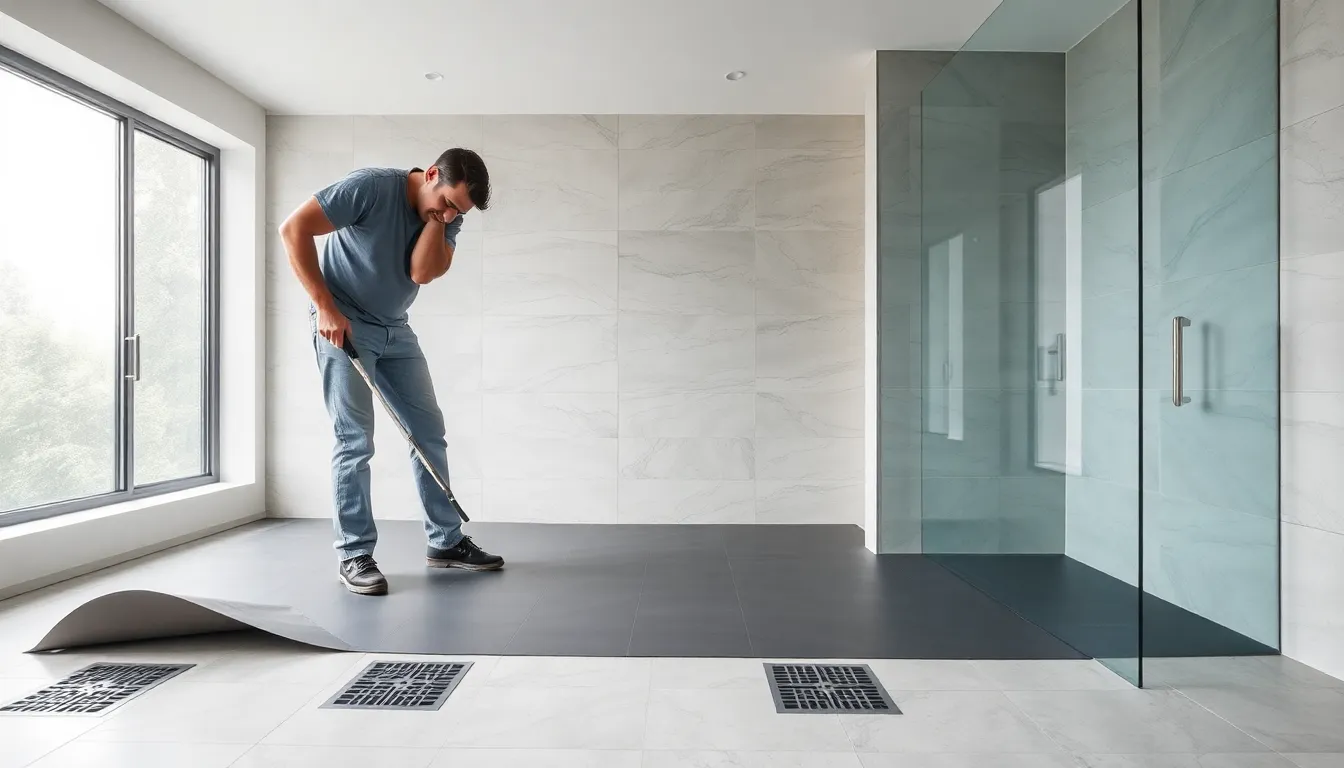
Waterproofing forms the foundation of every successful wet room installation, determining whether your investment thrives or fails over time. We’ll explore the critical requirements that protect your home from water damage while ensuring your wet room performs flawlessly for years to come.
Tanking and Membrane Installation Basics
Complete tanking transforms your wet room into an impenetrable barrier against water penetration. The entire floor and wall surfaces must receive full waterproof membrane coverage to prevent any moisture from reaching the structural elements beneath. Professional installers apply these specialized membranes using precise techniques that create seamless protection across every surface.
Membrane installation requires meticulous attention to detail at every junction and corner. We recommend using high-quality waterproof membranes that bond directly to the substrate, creating a continuous barrier that extends behind where tiles will be placed. Installation teams must ensure proper overlap at seams and use appropriate sealants at penetrations like pipes and fixtures.
Correct membrane positioning prevents water seepage that could compromise your wet room’s integrity. The waterproof layer extends up walls to a minimum height that accounts for splash zones and cleaning activities. Quality membranes also include reinforcement strips at vulnerable areas like corners and floor-to-wall transitions where movement might occur.
Drainage System Planning and Placement
Strategic drain placement ensures efficient water removal without creating standing water areas. We position drains at the lowest points of the wet room floor, typically near the shower area where most water accumulates. Multiple drain locations may be necessary in larger wet rooms to handle water flow effectively.
Proper slope and gradient calculations direct water toward drains using gravity flow principles. The floor must slope consistently at approximately 1:40 gradient (25mm per meter) to help smooth water movement without creating uncomfortable walking surfaces. Professional installers use specialized tools to achieve these precise measurements throughout the installation process.
Advanced drainage systems incorporate linear drains that handle high water volumes efficiently. These modern drain designs blend seamlessly with contemporary wet room aesthetics while providing superior performance compared to traditional point drains. Linear drains also allow for more flexible tile layout patterns and easier maintenance access.
Stunning Minimalist Wet Room Ideas for Small Spaces
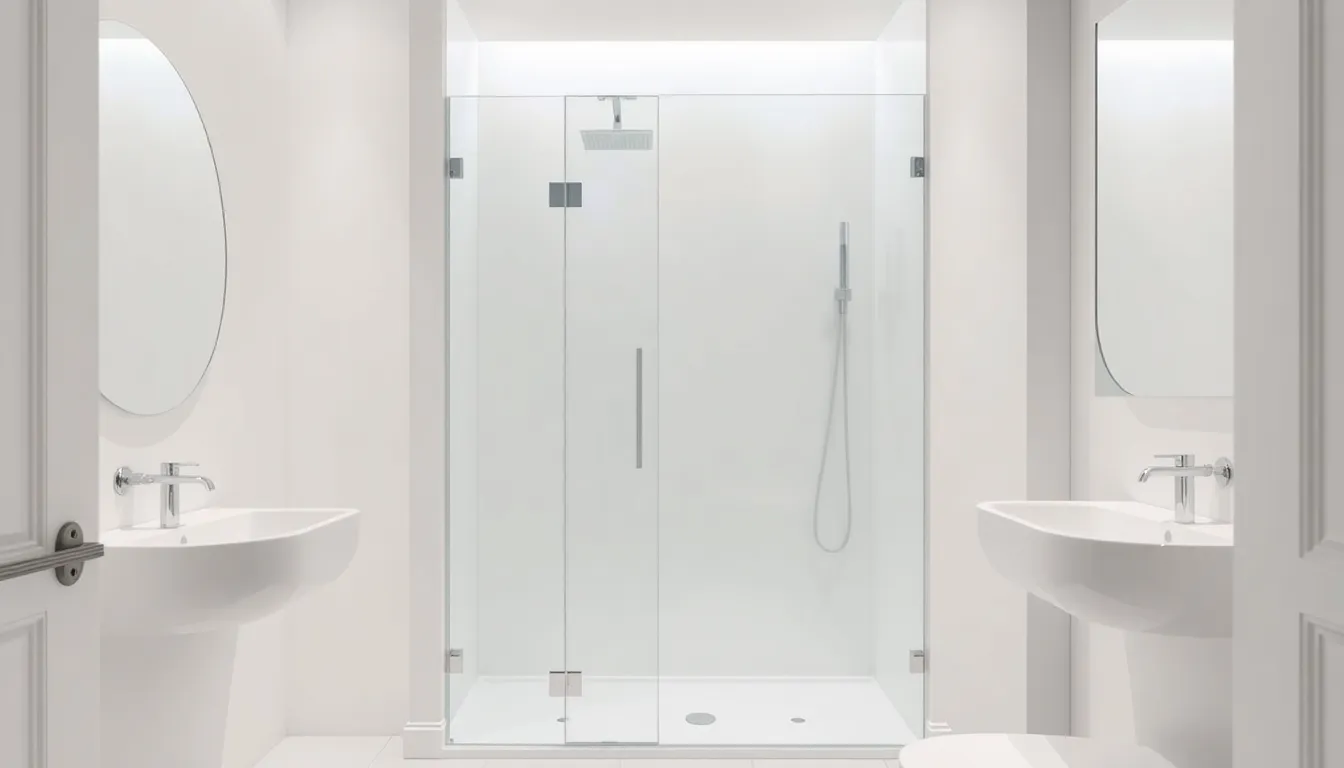
Small spaces don’t have to compromise on style when it comes to wet room design. We’ve discovered that strategic planning and smart material choices can transform even the most compact bathrooms into luxurious, spa-like retreats.
Glass Partition Answers for Compact Bathrooms
Glass shower doors create an immediate sense of openness by allowing light to flow freely throughout the space. We recommend installing transparent barriers that visually expand your bathroom while maintaining the practical separation needed for water containment.
Partition walls made from glass maintain continuity between different bathroom zones without creating visual breaks. Glass screens work exceptionally well when they match your existing hardware, creating a cohesive design that feels intentional rather than cluttered.
Transparent barriers eliminate the heavy visual weight that solid walls create in small spaces. We’ve found that floor-to-ceiling glass installations maximize the impact of this approach, making compact wet rooms feel significantly larger than their actual square footage.
Corner Shower Configurations That Maximize Space
Corner shower enclosures use previously wasted space by fitting snugly into room angles, freeing up valuable floor area for other bathroom essentials. These configurations work particularly well in tight quarters where every square inch matters.
Quadrant showers provide efficient space usage while offering ample interior room for comfortable showering. We’ve seen these designs successfully installed in bathrooms as small as 40 square feet, proving that size doesn’t limit luxury.
Foldable doors optimize space further by eliminating the swing radius required by traditional hinged doors. Bi-fold and sliding mechanisms work exceptionally well in corner installations, allowing full access to the shower area without encroaching on the rest of the bathroom.
Space-saving hardware becomes crucial in these compact configurations, with wall-mounted fixtures and recessed storage maintaining the clean lines essential to minimalist design. We recommend incorporating these elements during the initial planning phase to ensure seamless integration with your waterproofing and drainage systems.
Luxury Wet Room Ideas with Premium Materials
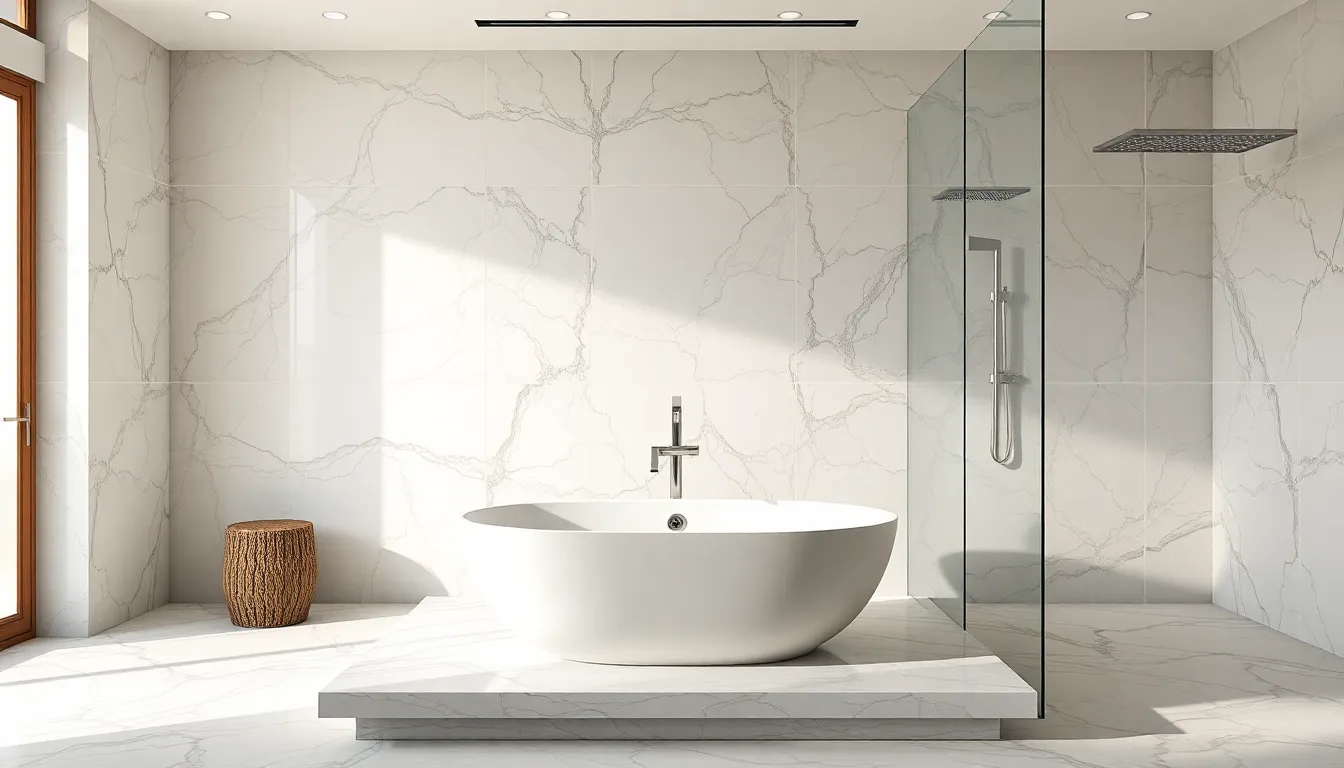
Premium materials elevate wet room designs from functional spaces to breathtaking sanctuaries that rival the industry’s finest spas. We’ll explore how sophisticated material choices and expertly placed fixtures create the ultimate luxury bathroom experience.
Natural Stone and Marble Wet Room Designs
Marble transforms wet rooms into stunning showcases of natural beauty and elegance. Large format marble tiles create seamless surfaces that make spaces appear larger while delivering that coveted spa atmosphere. We recommend travertine, slate, and marble options that bring unique textures and sophisticated color palettes to your wet room design.
Stone materials require proper sealing to maintain their pristine appearance and prevent water damage. Natural stone offers incredible variety in finishes and colors, allowing you to create distinctive patterns that reflect your personal style. These premium materials significantly increase your property value while providing the durability needed for daily wet room use.
Mosaic marble tiles add intricate detail and visual interest to wet room surfaces. We’ve found that stone walls paired with minimalist decor create that tranquil, high end aesthetic homeowners desire. Natural stone’s organic appeal reinforces the spa like environment that makes luxury wet rooms so appealing.
High-End Fixture Selection and Placement
Premium fixtures serve as the functional jewelry of luxury wet room designs. Rainfall showerheads, body jets, and smart water controls provide the ultimate bathing experience while maintaining the sophisticated aesthetic. We position these fixtures strategically to maximize both comfort and visual impact throughout the space.
Freestanding bathtubs integrated directly into wet areas create stunning focal points. Elevated tub platforms add distinction and visual separation while maintaining the open concept flow. Smart placement strategies ensure optimal user experience by positioning shower components for maximum coverage and convenience.
Material choices for fixtures reinforce the luxury theme while providing lasting durability. Brushed nickel, polished chrome, and brass options offer different aesthetic appeals that complement various design styles. We include built in niches and towel warmers for added convenience, while glass partitions preserve the airy feel that makes wet rooms so appealing.
Advanced fixture technology enhances both functionality and the overall bathing experience. Smart controls allow precise temperature and flow management, while heated floors add comfort during colder months. These premium additions justify the investment through improved daily use and increased home value.
Modern Wet Room Ideas Featuring Contemporary Elements
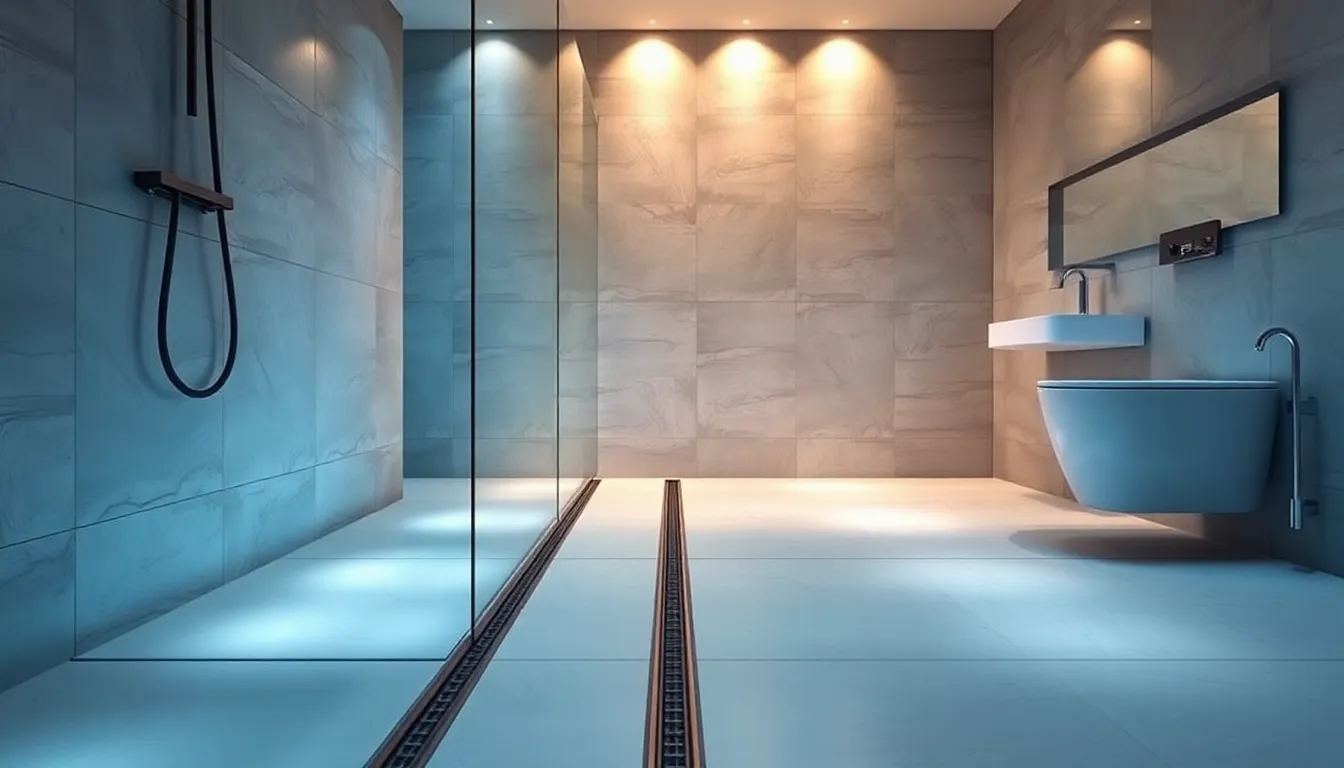
Today’s wet room designs embrace cutting-edge elements that blend style with functionality. We’ll explore how contemporary features can transform your space into a sophisticated bathing environment.
Sleek Linear Drainage Systems
Linear drainage systems define the aesthetic foundation of modern wet rooms with their minimalist approach to water management. We install these systems flush with the floor to support the open-plan concept that eliminates traditional raised shower trays. This seamless integration enhances accessibility while maintaining the clean lines that contemporary design demands.
Key Benefits of Linear Drains:
| Feature | Advantage |
|---|---|
| Flush Installation | Creates uninterrupted floor surfaces |
| Efficient Water Management | Handles high volumes effectively |
| Design Flexibility | Accommodates various tile patterns |
| Enhanced Accessibility | Eliminates trip hazards |
Linear drains offer superior water removal compared to traditional point drains. We position them strategically along walls or in central locations to optimize drainage flow. Their sleek profile supports the minimalist aesthetic while providing practical benefits like easier cleaning and maintenance.
Modern linear drainage systems feature customizable grates in materials like stainless steel, brass, or even tile-insert options. We recommend choosing grates that complement your overall design scheme. These systems work particularly well with large-format tiles and continuous surfaces that visually expand the room.
LED Lighting Integration for Ambient Appeal
LED lighting integration transforms wet rooms into tranquil, spa-like retreats through strategic placement and customizable features. We install recessed LED strips along walls, under vanities, and in niches to create ambient lighting that enhances the bathing experience. This lighting choice supports safety by improving visibility in wet areas while contributing to the luxurious atmosphere.
Popular LED Placement Options:
- Recessed strips along shower walls for dramatic accent lighting
- Under-vanity lighting that creates floating effects
- Niche illumination highlighting decorative elements
- Ceiling-integrated systems for general ambient lighting
LED technology offers customizable color temperatures to suit different moods and times of day. We configure systems with warm white (2700K-3000K) for relaxation and cooler temperatures (4000K-5000K) for task-oriented activities. Smart controls allow you to adjust brightness and color temperature throughout the day.
Waterproof LED fixtures ensure long-lasting performance in wet environments. We select IP65-rated or higher fixtures specifically designed for bathroom applications. These systems provide energy-efficient operation while maintaining consistent light output for years.
Strategic LED placement creates visual depth and highlights architectural features. We use lighting to emphasize texture in stone or tile surfaces, creating dramatic shadows and highlights. This technique adds dimensional interest to flat surfaces and enhances the overall design impact of your wet room.
Accessible Wet Room Ideas for Universal Design

Universal design principles make wet rooms incredibly functional for users of all abilities, creating spaces that prioritize safety and accessibility without compromising style.
Barrier-Free Entry Answers
Flush flooring creates seamless transitions throughout the entire bathroom space by leveling surfaces with gentle gradients toward central drains. We eliminate steps and lips that typically impede wheelchair users or individuals with limited mobility, ensuring smooth navigation from any direction.
Open layouts remove traditional shower barriers like curbs and doors that often create obstacles for assistive devices. These barrier-free designs allow unrestricted access from multiple angles, making the wet room truly inclusive for all users.
Strategic door placement enhances accessibility when privacy is required through wide sliding or pivot doors that operate easily with one hand. We recommend doors that accommodate wheelchairs and walkers while maintaining the open feel that makes wet rooms so appealing.
Safety Features and Grab Bar Integration
ADA-compliant grab bars provide essential support when strategically installed near toilets, shower areas, and along walls for maximum stability. We position these safety features at optimal heights to assist both seated and standing users during transfers and bathing activities.
Non-slip flooring materials reduce fall risks even when surfaces become wet, using slip-resistant tiles or matte-finish options that maintain traction. These safety-focused materials don’t sacrifice aesthetics while providing crucial protection against accidents.
Built-in seating options offer comfort and security through integrated benches or fold-down seats within the shower area. We design these features to support various user needs while blending seamlessly with the overall wet room aesthetic.
Optimal lighting ensures visibility and safety with bright LED fixtures providing uniform illumination throughout the space, including night lights for around-the-clock accessibility. We place shower controls and dispensers at accessible heights within easy reach for all users, regardless of their mobility level.
Creative Tile Patterns and Floor Ideas for Wet Rooms
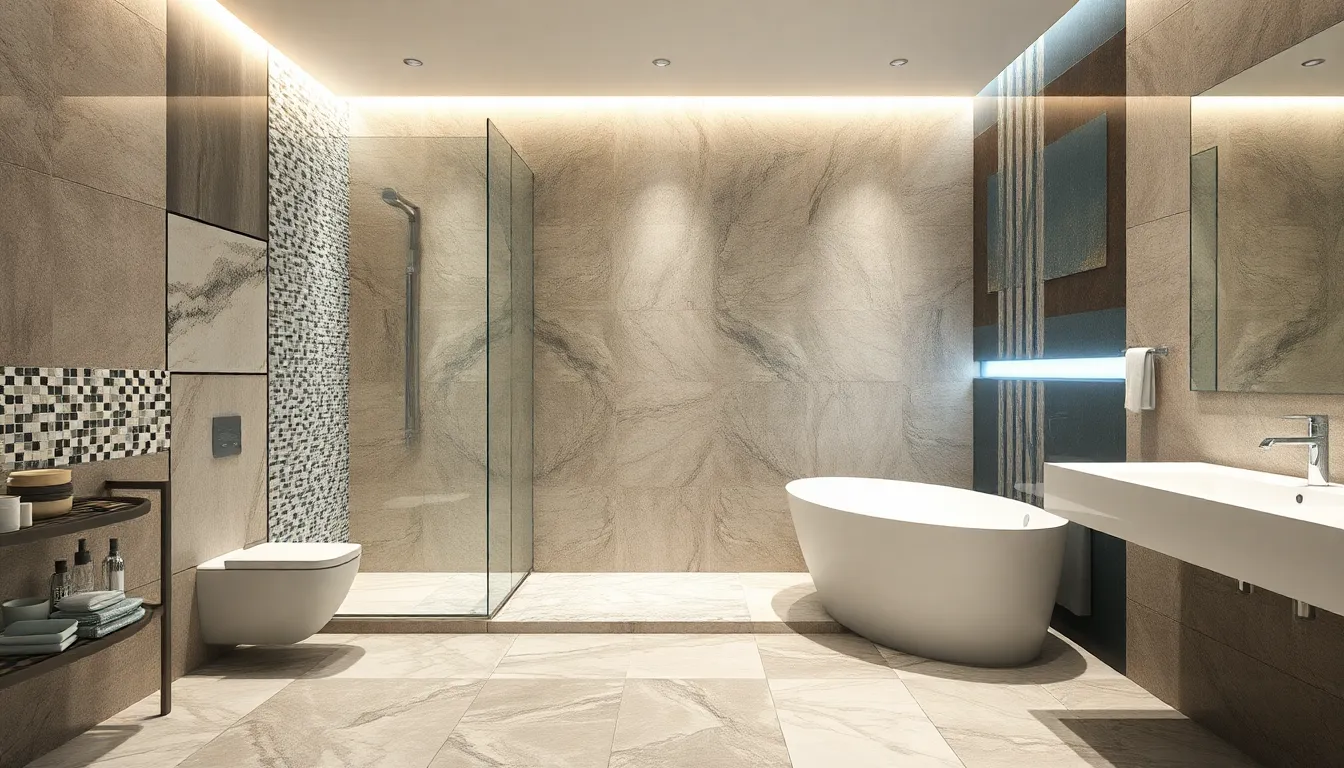
Transforming your wet room into a visual masterpiece starts with selecting the right tile patterns and flooring combinations. Strategic tile choices can dramatically enhance both safety and style while creating stunning focal points throughout your space.
Non-Slip Flooring Options and Textures
Porcelain tiles lead our recommendations for wet room flooring due to their exceptional durability and water resistance properties. These versatile tiles come in various textures specifically designed to provide enhanced traction in wet conditions, making them both practical and beautiful.
Textured flooring surfaces significantly reduce slip hazards while adding visual depth to your wet room design. Stone look porcelain tiles with subtle raised patterns create grip underfoot without compromising the sleek aesthetic you’re aiming for.
Large format tiles minimize grout lines throughout your flooring, creating a seamless appearance that makes even compact wet rooms feel more spacious. We recommend choosing tiles measuring 24×24 inches or larger to achieve this luxurious, uninterrupted look.
Mosaic tile patterns offer excellent slip resistance through their naturally textured surface created by multiple grout lines. Small format mosaics in natural stone or porcelain provide both safety and sophisticated visual appeal.
Penny round tiles deliver exceptional grip while creating timeless geometric patterns that complement both modern and traditional wet room designs. Their curved surfaces naturally channel water toward drainage points.
Feature Wall Designs That Make a Statement
Accent walls transform ordinary wet rooms into extraordinary spaces by incorporating bold colors or unique materials like natural wood paneling. We’ve seen stunning results when clients choose one wall as their primary design focus.
Patterned tiles create dramatic visual interest through geometric designs, bold stripes, or intricate mosaic arrangements. These patterns work especially well on shower walls where they won’t interfere with flooring safety requirements.
Natural materials bring warmth and texture to wet room designs, with wood paneling creating that sought after Scandi style feel. Properly sealed wood elements can withstand moisture while adding organic beauty to sterile bathroom spaces.
Contrasting color schemes enhance aesthetic appeal by mixing complementary tiles and bathroom elements throughout your wet room. Dark accent walls paired with light flooring create depth and visual hierarchy.
Strategic lighting features highlight exact design elements and create dramatic effects that showcase your tile choices. LED strip lighting behind translucent tiles or along accent walls adds another layer of visual interest to your wet room design.
Smart Storage Solutions for Wet Room Functionality
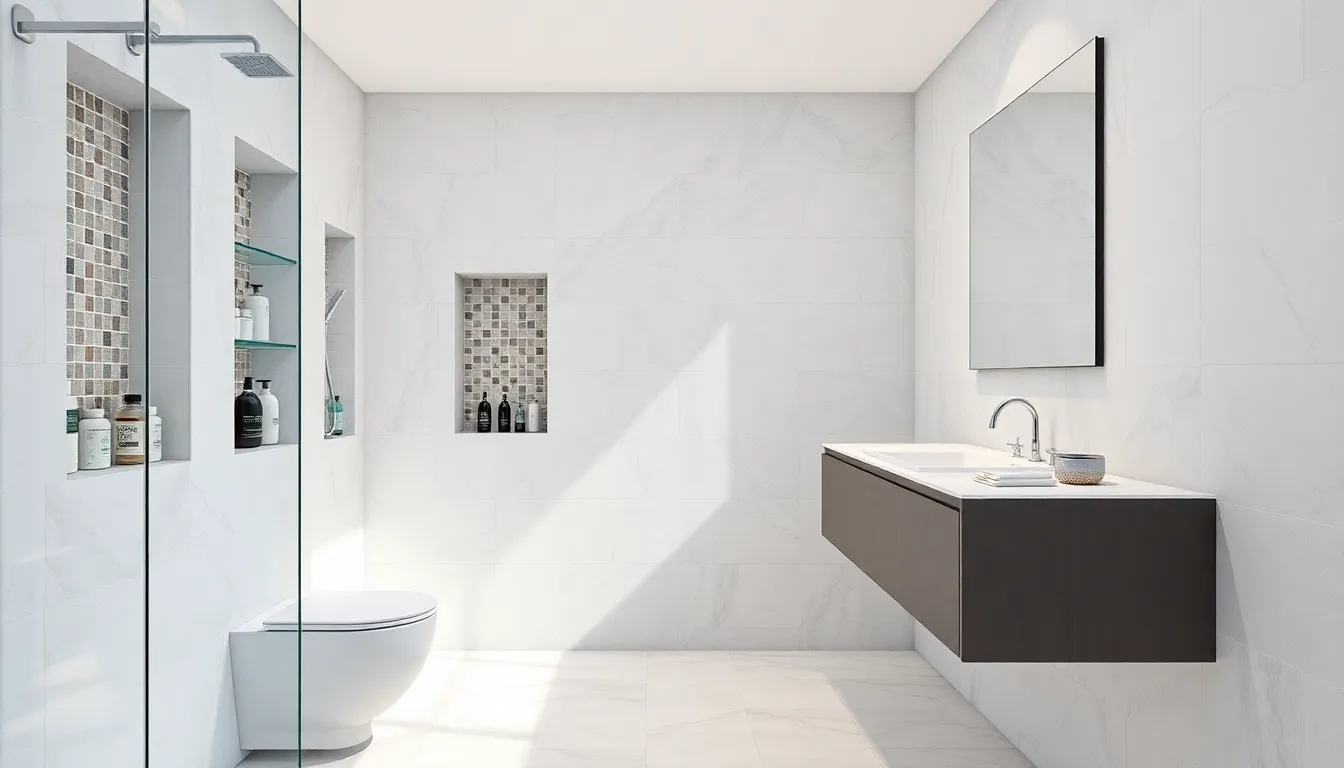
Storage challenges in wet rooms require innovative approaches that blend functionality with moisture resistance. We’ll explore practical answers that maximize space while maintaining the sleek aesthetic you’ve carefully crafted.
Built-In Niche Ideas for Toiletries
Recessed shower niches transform empty wall cavities into essential storage spaces that keep toiletries within arm’s reach during bathing. Built into the shower wall, these niches eliminate the need for hanging organizers that can interrupt clean lines and create maintenance challenges.
Tiled niche designs create seamless integration with your wet room’s overall aesthetic by matching existing tile patterns and colors. Installing these niches at varying heights accommodates different family members and provides dedicated spaces for exact items like razors, soap dispensers, and shampoo bottles.
Corner niche installations use often wasted angular spaces to provide additional storage without protruding into the main shower area. These strategic placements work particularly well in smaller wet rooms where every square inch matters for both storage and movement.
Multiple tier configurations allow you to separate different product categories across various shelf levels within a single niche opening. Creating distinct zones for body wash, hair products, and face cleansers helps maintain organization while preventing bottles from toppling during use.
Floating Vanity Options That Resist Moisture
Wall mounted vanities elevate storage off the floor to prevent moisture accumulation underneath while creating an illusion of more space. These installations require proper wall anchoring systems that can support both the vanity weight and daily usage loads without compromising structural integrity.
Waterproof material selections like marine grade plywood, solid surface composites, or specially treated hardwoods ensure your floating vanity withstands constant humidity exposure. Glass and metal combinations offer contemporary aesthetics while providing superior moisture resistance compared to traditional wood veneer options.
Integrated drainage features prevent water pooling on vanity surfaces through subtle slope designs or built in drip edges that direct moisture away from storage areas. Installing these elements during construction ensures proper water management without affecting the vanity’s visual appeal.
Concealed storage compartments maximize functionality by incorporating hidden drawers or pull out organizers within the floating vanity structure. These features maintain clean exterior lines while providing ample space for toiletries, cleaning supplies, and personal items that need protection from bathroom humidity.
Ventilation and Heating Ideas for Comfortable Wet Rooms
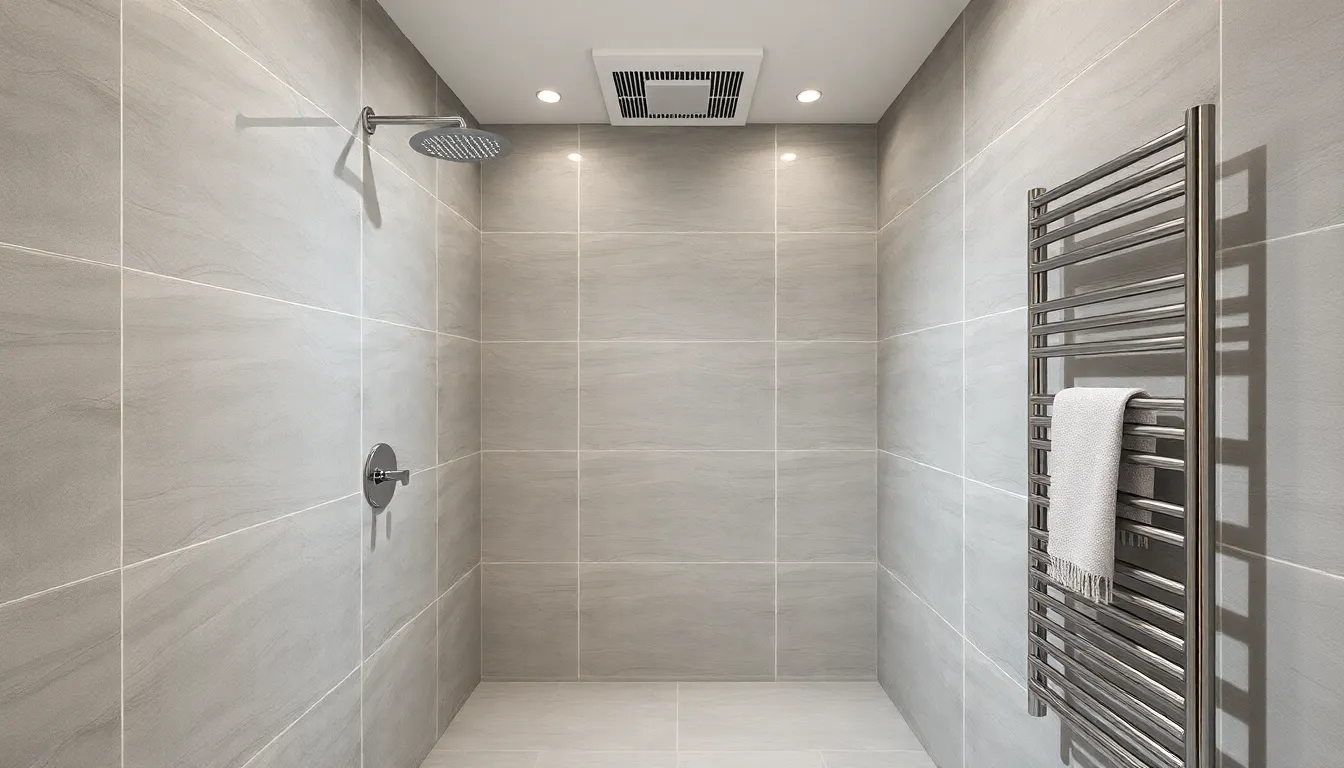
Proper ventilation and heating systems are crucial components that transform wet rooms from potentially problematic spaces into comfortable, moisture-controlled environments. We’ll explore strategic answers that maintain air quality while ensuring year-round comfort.
Exhaust Fan Placement for Optimal Air Circulation
Positioning exhaust fans near shower areas maximizes steam removal efficiency and prevents humidity buildup throughout your wet room. We recommend installing your primary exhaust fan directly above or adjacent to the shower zone where the most moisture is generated.
GFCI-protected wet-rated exhaust fans provide essential safety features while managing moisture effectively. Select models that move air at 1 cubic foot per minute per square foot of floor space for optimal performance.
Cross-ventilation strategies enhance air movement by creating strategic airflow patterns that prevent stagnant humid zones. Position secondary fans or vents opposite your primary exhaust fan to establish continuous air circulation.
Multiple fan installations work best in larger wet rooms or spaces with enclosed steam showers. Install an additional fan in open areas when your wet room includes separate shower enclosures to ensure thorough air circulation throughout the entire space.
Intelligent humidity sensors automate ventilation timing and reduce manual monitoring while clearing steam quickly. These smart controls activate fans automatically when moisture levels rise and continue operating until humidity returns to optimal levels.
| Fan Specification | Recommended Rate | Example Room Size |
|---|---|---|
| Standard ceiling height | 1 cfm per sq ft | 80 cfm for 8×10 ft room |
| High ceiling (over 8 ft) | Add 20% to base rate | 96 cfm for 8×10 ft room |
Underfloor Heating Systems for Year-Round Comfort
Underfloor heating systems accelerate surface drying while maintaining comfortable temperatures that reduce slip hazards and mold growth risks. We recommend electric radiant heating for wet rooms due to precise temperature control and moisture resistance.
Strategic heating cable placement requires coordination with drainage and waterproofing systems to prevent system failures. Avoid installing heating elements too close to drains or over movement joints where structural shifting could damage cables.
Temperature regulation improves both comfort and functionality by keeping floors warm underfoot while helping surfaces dry faster after use. Set systems to maintain consistent temperatures that discourage moisture accumulation without creating excessive heat.
Integration with wall-mounted towel warmers enhances luxury and practicality, especially in busy households where multiple users require dry towels throughout the day. Combine underfloor heating with heated towel rails for comprehensive warmth distribution.
Climate considerations make underfloor heating particularly beneficial in colder regions where temperature differences between air and surfaces create more condensation. These systems are especially valuable for maintaining comfort during winter months when natural drying is slower.
Mirror demisters work alongside heating systems to prevent fogging and maintain clear reflective surfaces throughout your bathing routine. Install these features as part of your comprehensive heating strategy for maximum convenience.
Budget-Friendly Wet Room Ideas That Don’t Compromise Style
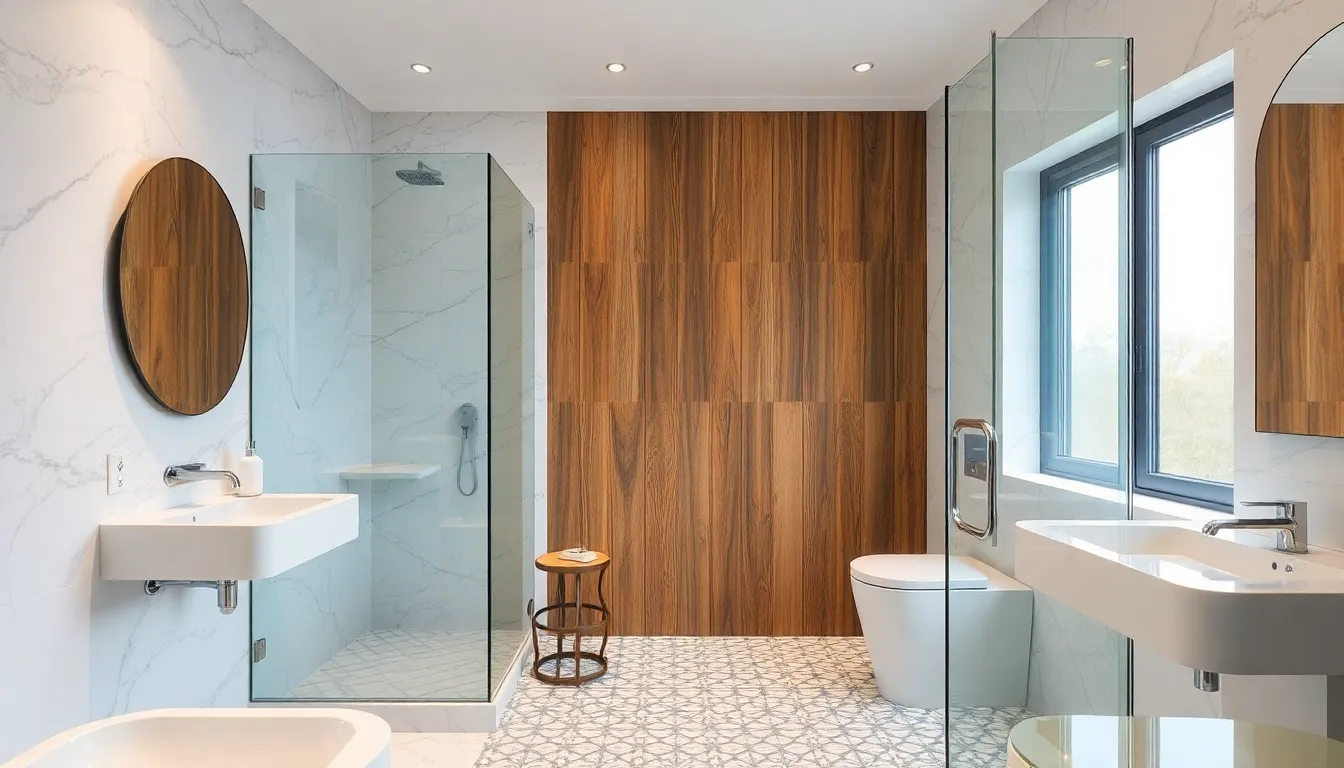
Creating a stylish wet room doesn’t require very costly. Smart design choices and strategic material selection can deliver the luxury wet room experience you want while keeping costs manageable.
DIY Installation Tips for Cost Savings
Tanking your wet room yourself represents one of the most important opportunities for cost reduction. DIY tanking kits provide everything needed to waterproof the space effectively, and following manufacturer instructions carefully ensures professional-grade results. We recommend starting with the floor area first, then working up the walls systematically to create a complete moisture barrier.
Installing tiles personally can save hundreds or even thousands in labor costs. Basic tile installation skills are learnable through online tutorials, and starting with larger format tiles makes the process more manageable for beginners. Practice your technique on a small test area first to build confidence before tackling the main surfaces.
Selecting low cost fixtures that match your existing hardware maintains design cohesion without premium pricing. Shopping during end of season sales or checking for discontinued models often yields high quality fixtures at important discounts. Focus your budget on essential waterproofing elements first, then allocate remaining funds to fixtures and finishes.
Planning your layout carefully before beginning work prevents costly mistakes and material waste. Measure twice and cut once applies especially to wet room installations where precision matters for proper drainage and waterproofing. Creating detailed plans helps you order exact material quantities and avoid expensive rush orders for forgotten items.
Affordable Material Alternatives That Look Expensive
Porcelain tiles instead of marble deliver stunning visual impact at a fraction of the cost. Modern porcelain manufacturing creates incredibly realistic marble patterns and textures that fool even experienced designers. These tiles also offer superior durability and lower maintenance requirements compared to natural stone options.
Reclaimed wood elements add warmth and luxury without the premium price tag of new exotic woods. Properly sealed reclaimed wood creates beautiful accent walls or vanity surfaces that tell a story while saving money. Source materials from local demolition projects or specialty reclaimed lumber yards for the best deals.
Glass shower screens create an elegant enclosure solution that costs significantly less than full custom installations. Standard sized screens work well in most wet room configurations and maintain the open feel that makes these spaces so appealing. Clear glass maximizes light flow while frosted options provide privacy without sacrificing style.
Ceramic alternatives to natural stone offer remarkable visual similarity at budget friendly prices. Large format ceramic tiles mimic expensive materials like travertine and slate while providing easier installation and maintenance. These materials resist staining and require minimal sealing compared to their natural counterparts.
Patterned tiles as focal points create visual interest without expensive decorative elements. Strategic placement of patterned tiles on feature walls or floors draws attention while keeping costs controlled. Mix these accent tiles with solid colored options to maximize impact while minimizing expense.
Conclusion
We’ve explored the incredible potential of wet room designs to transform your bathroom into a stunning sanctuary that combines style functionality and value. From budget-conscious DIY approaches to luxury installations featuring premium materials wet rooms offer answers for every homeowner’s needs and preferences.
The key to success lies in careful planning proper waterproofing and thoughtful design choices that maximize your space while ensuring long-term durability. Whether you’re working with a compact bathroom or designing a spacious retreat the versatility of wet room concepts allows for endless creativity.
With smart storage answers efficient ventilation systems and accessible design features wet rooms represent the future of bathroom design. They’re not just a trend – they’re a practical investment that enhances daily comfort while adding important value to your home for years to come.
Frequently Asked Questions
What is a wet room?
A wet room is a fully waterproof bathroom space that eliminates traditional shower enclosures and barriers. The entire room is designed to handle water, creating a seamless, open-concept environment where water drains directly from the floor. This design transforms ordinary bathrooms into spa-like retreats with enhanced visual appeal and functionality.
How much does it cost to install a wet room?
Wet room installations typically cost 40-60% more than traditional bathroom renovations. Budget ranges vary by component: waterproofing membranes, drainage systems, tiling, and fixtures all contribute to the total cost. While the initial investment is higher, long-term savings through reduced maintenance and increased property value can offset these expenses.
Do wet rooms increase home value?
Yes, wet rooms can significantly increase property value. Real estate professionals report higher bathroom valuations for homes featuring wet room designs. The luxurious, spa-like appeal and improved accessibility make these spaces attractive to potential buyers, making them a worthwhile investment for homeowners.
Are wet rooms suitable for small bathrooms?
Absolutely! Wet rooms are ideal for small bathrooms because they eliminate bulky shower enclosures, creating an illusion of more space. Strategic planning, smart material choices, and features like glass partitions can transform compact bathrooms into luxurious, functional environments without sacrificing style or comfort.
What waterproofing is required for wet rooms?
Complete tanking and waterproof membrane installation are essential for wet rooms. All surfaces must be properly sealed to prevent water damage. This meticulous process involves applying waterproof membranes to walls, floors, and joints, along with strategic drainage planning to ensure efficient water removal and long-term protection.
Can I install a wet room myself?
While some DIY elements are possible, professional installation is recommended for critical components like waterproofing and drainage systems. DIY options include using tanking kits and learning basic tile installation skills, but improper installation can lead to costly water damage and structural issues.
What flooring is best for wet rooms?
Non-slip flooring is crucial for wet room safety. Porcelain tiles are highly recommended for their durability and slip resistance. Large format tiles minimize grout lines, while mosaic tiles provide excellent grip. Natural stone requires proper sealing, and textured surfaces enhance safety without compromising aesthetics.
Do wet rooms need special ventilation?
Yes, proper ventilation is essential for wet rooms to control moisture and prevent mold growth. Optimal exhaust fan placement, cross-ventilation strategies, and intelligent humidity sensors help maintain air quality. Adequate ventilation protects the structure and ensures a comfortable, healthy environment.
What are the benefits of wet room design?
Wet rooms offer numerous advantages: they create a spacious feel, require easier maintenance, improve accessibility for mobility-challenged users, and provide design flexibility. The open-concept layout eliminates cleaning corners and barriers, while the seamless design allows for creative tile patterns and premium fixtures.
How do I budget for a wet room renovation?
Factor in waterproofing, drainage systems, tiling, fixtures, and professional installation costs. Consider permit requirements and potential structural modifications. While initial costs are higher, budget-friendly options include DIY elements, affordable materials like porcelain tiles, and strategic planning to avoid costly mistakes during installation.
